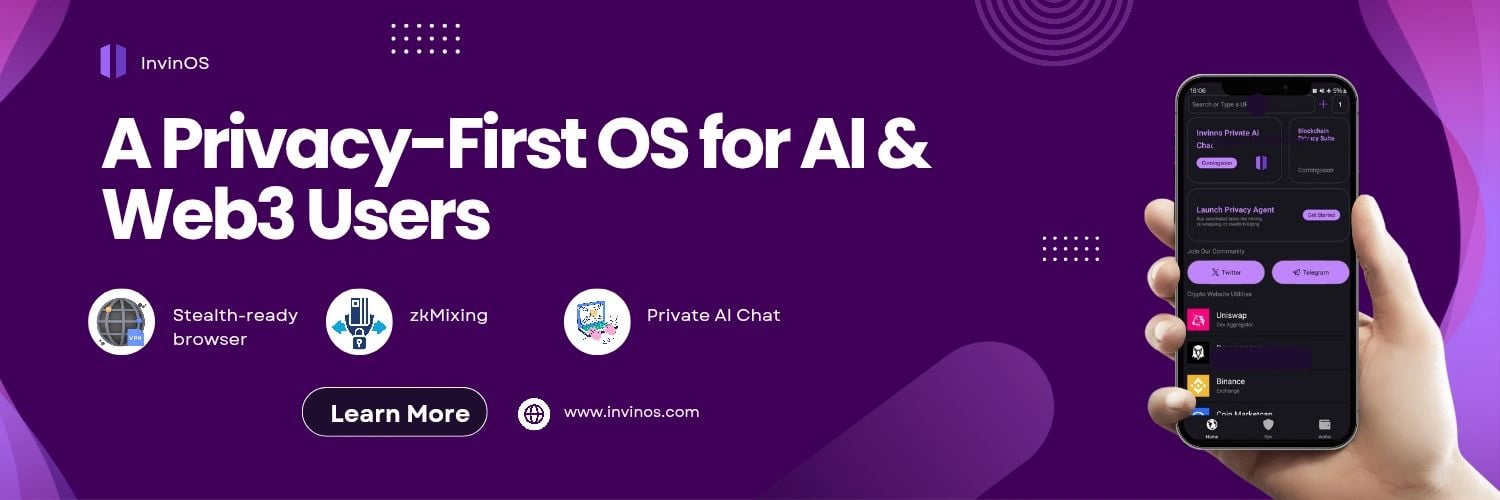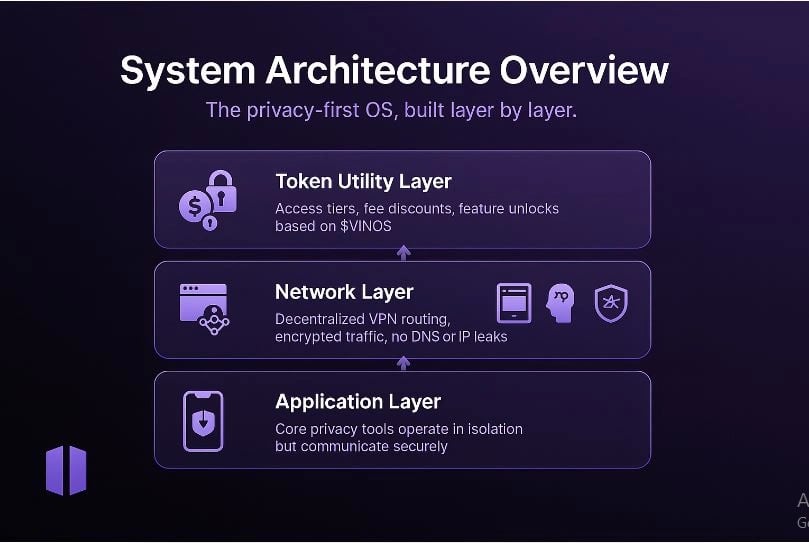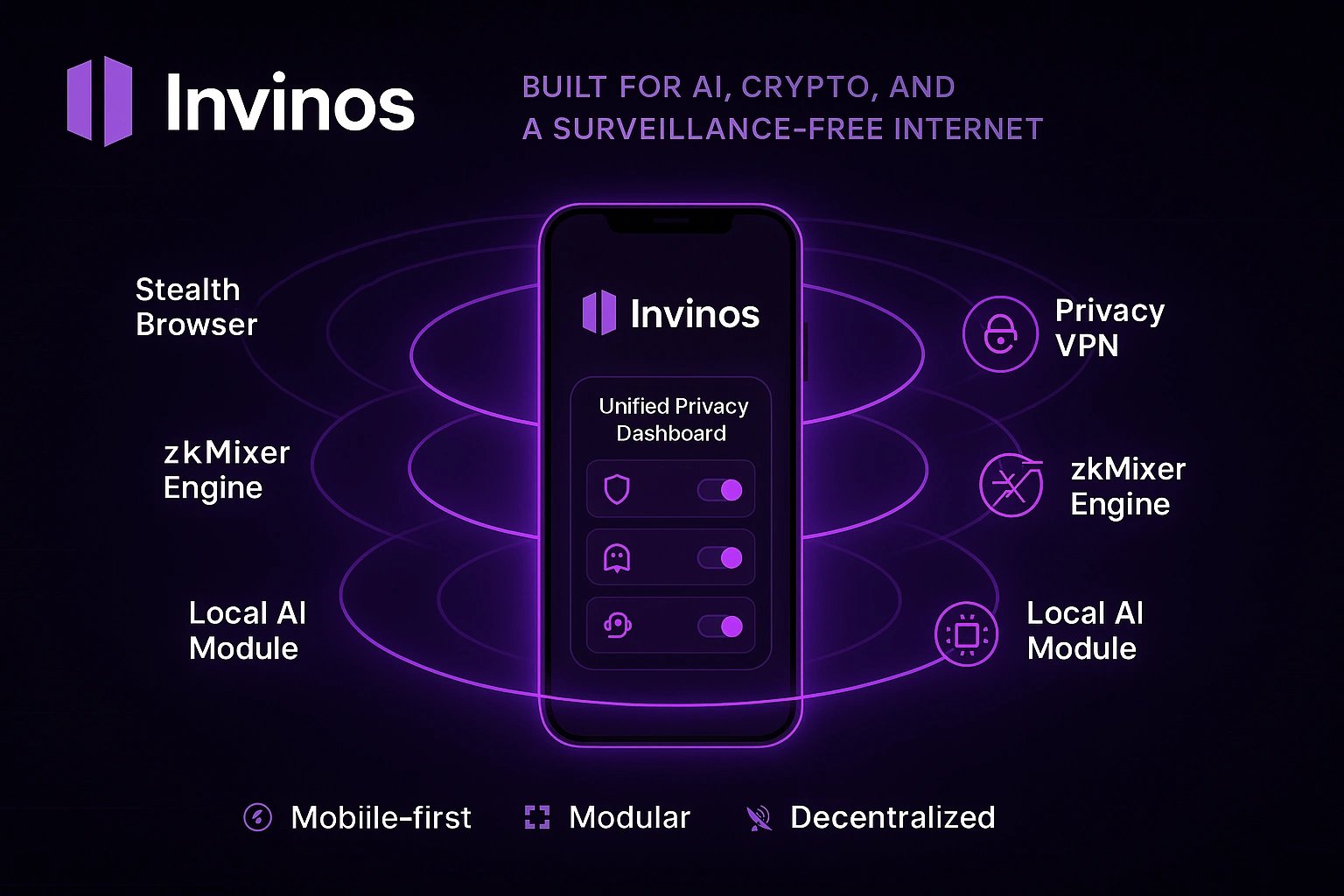위키 구독하기
Share wiki
Bookmark
INVINOS
INVINOS
Invinos(인비노스)는 암호화된 AI 도구, 익명의 블록체인 인프라 및 탈중앙화 애플리케이션을 사용자 프라이버시에 중점을 둔 통합 시스템으로 통합하도록 설계된 AI 및 블록체인 프라이버시 운영 체제입니다. 개인적인 디지털 상호 작용 및 거래를 위한 플랫폼을 제공하는 것을 목표로 합니다. [35]

개요
Invinos(인비노스)는 AI 도구, 블록체인 네트워크 및 인터넷과의 안전한 상호 작용을 지원하는 모바일 우선, 개인 정보 보호 중심 운영 체제입니다. 추적 차단 브라우저, 분산형 VPN, 크로스체인 믹서, 임시 지갑 및 로컬 AI 추론과 같은 여러 개인 정보 보호 기능을 단일 통합 환경에 통합합니다. Android 기기용으로 제작된 Invinos는 기본적으로 데이터 노출을 제거하고 중앙 집중식 종속성이나 사용자 식별 없이 작동합니다. 개인 웹 브라우징, 추적 불가능한 온체인 트랜잭션 및 외부 로깅 없이 AI 쿼리를 지원합니다. 모듈식 시스템을 통해 사용자는 필요한 개인 정보 보호 도구만 활성화하여 계층화된 보호를 활성화할 수 있습니다.
Invinos는 증가하는 디지털 감시에 대한 대응으로 만들어졌으며, DeFi 참여자, 개발자 및 언론인과 같이 강력한 개인 정보 보호가 필요한 개인을 위해 고안되었습니다. 그 인프라는 분산화, 사용자 자율성 및 최소한의 데이터 공간을 강조하여 독립형 VPN 또는 믹서와 같은 단일 목적 도구와 차별화됩니다. [1]
건축

디자인 계층
인비노스는 디지털 상호 작용의 다양한 측면을 보호하는 여섯 개의 독립적인 디자인 계층으로 구성됩니다. 단일 통합 시스템에 의존하는 대신, 인비노스의 아키텍처는 기능을 전문화된 모듈로 분리하여 위험을 최소화하고 메타데이터 노출을 제한하며 단일 지점 장애를 방지합니다. 이러한 모듈식 구조는 보안과 적응성을 모두 제공하기 위한 의도적인 설계입니다.
각 계층은 추적 방지, 메타데이터 유출 방지, 인터넷, 금융 도구 및 AI 시스템의 개인적이고 제한 없는 사용을 가능하게 하는 세 가지 주요 목표를 지원합니다. 웹 트래픽, 세션 데이터, 지갑 활동 또는 사용자 ID를 처리하든 관계없이 모든 구성 요소는 다양한 개인 정보 보호 요구 사항에 맞게 조정되는 광범위한 시스템에 기여합니다.
이러한 계층은 액세스 및 조정을 용이하게 하기 위해 중앙 집중식 대시보드를 통해 관리되지만 사용자 요구 사항 또는 위협 수준에 따라 독립적으로 기능할 수도 있습니다. 이러한 유연한 프레임워크를 통해 인비노스는 기본적인 보호를 원하는 개인부터 고위험 환경에서 운영되는 전문가까지 광범위한 사용자에게 서비스를 제공할 수 있습니다. [2]
네트워크
네트워크 계층은 인비노스(Invinos)의 개인 정보 보호 아키텍처의 기반을 형성하며, 사용자 기기의 모든 송수신 통신을 처리합니다. 사용자 메타데이터를 모니터링하거나 저장할 수 있는 중앙 집중식 ISP 또는 VPN 제공업체에 의존하는 기존 시스템과 달리, 인비노스는 분산된 피어투피어(peer-to-peer) VPN 터널을 사용합니다. 이 시스템은 추적을 방지하기 위해 여러 익명 릴레이를 통해 인터넷 트래픽을 라우팅합니다.
데이터 패킷은 멀티홉 라우팅을 사용하여 여러 단계에서 암호화되므로 단일 노드가 원본과 대상을 볼 수 없습니다. DNS 요청은 익명 채널을 통해 해결되어 도메인 수준 추적을 방지하고, 패킷 패딩은 크기와 시간을 불분명하게 하여 트래픽 패턴 분석의 위험을 줄입니다.
이 계층은 외부 서비스(웹사이트, 앱 및 블록체인 플랫폼)가 사용자 위치, 기기 세부 정보 또는 상관된 활동을 감지하는 것을 방지합니다. 이 계층은 지속적으로 작동하며 시스템의 다른 모든 모듈을 뒷받침하여 감시에 대한 주요 방어벽 역할을 합니다. [3]
브라우저
Invinos의 브라우저 계층은 가장 일반적인 감시 소스 중 하나인 브라우저 지문 및 행동 추적을 제거하도록 설계되었습니다. 개인 모드에서도 기존 브라우저는 글꼴, 해상도, 언어 설정 및 입력 패턴과 같은 데이터 지점을 노출하며, 이러한 모든 지점은 지속적인 사용자 프로필을 구축하는 데 사용될 수 있습니다. Invinos는 완전히 격리된 일회용 환경에서 각 세션을 시작하는 은밀한 브라우저를 생성하여 이 문제를 해결합니다.
각 브라우징 세션은 샌드박스화되며, 지속적인 쿠키, 캐시 또는 식별자가 이전되지 않습니다. 화면 크기, 시간대 및 키보드 동작과 같은 식별 가능한 속성은 세션마다 무작위로 지정됩니다. 자바스크립트 실행은 제한되고 모니터링되어 지문 생성 시도를 차단하며, 추적 스크립트는 네트워크 및 애플리케이션 수준에서 적극적으로 필터링됩니다.
세션 기록은 저장되지 않으며, 브라우저는 제3자 공급업체 또는 상위 서비스에 대한 신뢰에 의존하지 않습니다. 모든 페이지 보기는 포함되고 이전 활동과 연결되지 않으며 세션이 종료될 때 삭제됩니다. 이러한 접근 방식을 통해 사용자는 프로파일링, 타겟팅 또는 장기간 데이터 수집에 노출되지 않고 웹을 탐색할 수 있습니다. [4]
지갑 및 자산
인비노스의 지갑 및 자산 계층은 고스트 지갑(ghost wallets)을 통해 온체인 프라이버시를 보존하는 데 중점을 둡니다. 고스트 지갑은 각 금융 세션마다 자동으로 생성되는 임시적인 일회용 주소입니다. 이러한 지갑은 중앙 계정이나 신원에 연결되지 않으며 재사용되지 않으므로 추적 가능한 거래 내역이 생성되지 않습니다.
자산 이동을 더욱 은폐하기 위해 인비노스는 zkMixer라는 거래 믹서를 통합했습니다. 이 시스템을 사용하면 사용자가 한 체인에 자산을 입금하고 다른 주소를 사용하여 다른 체인에서 다른 자산을 인출할 수 있으므로 두 지점 간의 추적성이 끊어집니다. 이렇게 함으로써 지갑 계층은 사용자를 탈중앙화 금융 및 블록체인 기반 애플리케이션에서 클러스터링 분석, 프런트러닝 및 신원 기반 타겟팅으로부터 보호합니다. [5]
컴퓨팅 (AI)
인비노스의 컴퓨팅 계층은 모든 처리가 클라우드가 아닌 기기에서 로컬로 수행되도록 함으로써 AI 사용에 대한 개인 정보 보호 문제를 해결합니다. 사용자 프롬프트와 응답을 기록하는 대부분의 AI 도구와 달리, 인비노스는 양자화된 가중치와 GPU 가속을 사용하여 모바일 하드웨어에서 최적화된 언어 모델을 직접 실행하여 외부 데이터 노출을 제거합니다.
프롬프트는 런타임 중에 암호화되며, 처리 후에는 추론 데이터가 저장되지 않아 사용자 입력의 기밀성이 유지됩니다. 이러한 설정을 통해 사용자는 AI 모델과 개인적으로 상호 작용할 수 있습니다. 향후 업데이트에는 암호화된 프롬프트 시퀀스, 협업 에이전트, 분산형 스마트 계약 실행 지원이 포함될 계획입니다. [6]
신원
Invinos의 신원 계층은 암호화 방법을 사용하여 익명이고 검증 가능한 신원을 생성함으로써 기존의 계정, 이메일 또는 소셜 로그인의 필요성을 제거합니다. 신원을 개인 정보에 연결하는 대신 사용자는 개인 정보를 유지하는 암호화 증명을 통해 상호 작용합니다.
zk-Identity를 사용하면 개인은 지갑 주소나 개인 정보를 공개하지 않고도 자격 증명, 거버넌스 권한 또는 평판의 소유권을 증명할 수 있습니다. 이러한 휴대용 신원은 키 백업으로 복구할 수 있으며 제로지식 증명과 머클 트리 증명을 지원하여 안전하고 개인적인 검증을 수행합니다. [7]
인터페이스 및 대시보드
인터페이스 및 대시보드 계층은 Invinos(인비노스) 내에서 사용자의 로컬 제어 센터 역할을 합니다. 활성 개인 정보 보호 모듈의 상태를 표시하고, 실시간 개인 정보 보호 메트릭을 제공하며, 사용자는 현재 필요에 따라 설정을 조정할 수 있습니다. zkMixer(지케이믹서)와 같은 기능은 개인 정보 보호를 저해하지 않고 상황에 따라 활성화 또는 비활성화할 수 있습니다.
모든 대시보드 기능은 외부 통신이나 데이터 저장 없이 로컬에서 작동합니다. 이러한 설계를 통해 사용자 인터페이스가 감시 또는 정보 유출의 원인이 되지 않도록 합니다. [9]
서버리스
인비노스는 중앙 집중식 서버 없이 운영되며 대신 분산 및 로컬 시스템에 의존합니다. 앱 및 메타데이터 배포에는 IPFS를, 네트워크 라우팅에는 분산 VPN 릴레이어를, 그리고 zkMixer에는 Ethereum 및 Polygon과 같은 공용 블록체인을 사용합니다. 신원, 증명 및 지갑 기능은 오픈소스 암호화 라이브러리를 통해 처리되며, AI 작업은 최적화된 추론 도구를 사용하여 기기에서 완전히 실행됩니다.
이러한 아키텍처는 인비노스를 검열에 강력하게 만들고 단일 장애 지점에 의존하지 않도록 합니다. 광범위한 인프라의 일부가 사용할 수 없게 되더라도 핵심 기능은 계속 액세스할 수 있습니다. [9]
모바일 우선
Invinos(인비노스)는 모든 구성 요소가 Android 기기에서 효율적으로 실행되도록 최적화되어 주로 모바일 사용을 위해 구축되었습니다. 로컬 AI 모델은 성능 향상을 위해 양자화되고, 브라우저는 GPU 가속 및 탭당 격리된 메모리를 사용하며, VPN 계층은 배터리 사용량을 줄이기 위해 경량 WireGuard 기반 릴레이에서 실행됩니다.
시스템은 백그라운드 서비스 또는 앱 스토어 배포에 의존하지 않고 작동합니다. 사용자는 분산형 APK 링크를 통해 설치하고, IPFS 매니페스트를 통해 업데이트를 관리합니다. 이러한 접근 방식은 데스크톱 환경에 국한되지 않고 모바일 기기에서 포괄적인 개인 정보 보호를 보장합니다. [36]
앱 모듈

스텔스 브라우저
Invinos의 스텔스 브라우저는 사용자의 행동이나 기기 정보를 노출하지 않고 인터넷에 접속할 수 있도록 합니다. 각 세션은 지속적인 저장 공간 없이 격리된 컨테이너에서 실행되므로 세션이 종료될 때 쿠키, 캐시 및 로그가 삭제됩니다.
추적을 차단하기 위해 브라우저는 화면 크기 및 글꼴과 같은 기기 속성을 무작위로 지정하고, 프로파일링을 방지하기 위해 JavaScript를 샌드박스화하며, DNS 수준에서 타사 스크립트 및 추적기를 필터링합니다. 이러한 설정을 통해 사이트가 식별 데이터를 수집하는 것을 방지하여 표준적인 브라우징 환경을 제공합니다. [10] [11]
프라이버시 VPN
인비노스의 VPN은 중앙 집중식 서버에 의존하지 않고 모든 트래픽을 암호화하는 분산형 멀티홉 릴레이 네트워크를 통해 작동합니다. 각 패킷은 암호화 계층으로 처리되고 회전하는 릴레이를 통해 라우팅되어 어떤 노드도 패킷의 출발지와 도착지를 연결할 수 없습니다.
암호화된 DNS 처리 및 동적 IP 마스킹은 브라우징 활동과 위치를 더욱 은폐합니다. VPN은 자동으로 실행되며 설정이 필요 없으므로 사용자는 IP 주소 또는 실제 위치를 공개하지 않고 온라인 서비스에 액세스할 수 있습니다(인비노스 포함). [12]
zkMixer
zkMixer는 Invinos의 시스템으로, 입금 및 출금 활동 간의 연결을 끊어 자산 이전을 숨기는 역할을 합니다. 사용자는 하나의 토큰을 입금하고 나중에 다른 토큰을 별도의 주소와 체인으로 출금할 수 있으며, 추적 가능한 연결이 없습니다.
이 프로세스에는 트랜잭션 배치, 무작위 지연 및 임시 지갑을 통한 라우팅이 포함됩니다. 강력한 실질적인 개인 정보 보호 기능을 제공하며, 공식적인 비연결성을 위해 영지식 증명을 추가할 계획입니다. 사용에는 계정, 로그인 또는 영구적인 상태가 필요하지 않습니다. 각 세션은 완전히 암호화되고 익명으로 유지됩니다. [13]
고스트 지갑
고스트 지갑은 일회용 상호 작용을 위해 로컬에서 생성되는 임시 블록체인 지갑입니다. 지속적인 이력을 가진 기존 지갑과 달리, 이 지갑은 필요에 따라 생성되고 사용 후 폐기되어 장기적인 흔적을 남기지 않습니다.
고스트 지갑은 키 생성을 위해 기기 기반 엔트로피에 의존하며 사용자 ID 또는 중앙 집중식 저장소에 절대 연결되지 않습니다. 개인 dApp 사용, 자산 이전 및 거버넌스 참여를 지원하며, zkMixer와 함께 사용하여 트랜잭션이 연결되지 않도록 할 수 있습니다. [14]
익명 DEX
인비노스의 익명 탈중앙화 거래소(DEX)는 사용자 신원이나 거래 패턴을 노출하지 않고 크로스체인 자산 스왑을 가능하게 합니다. 세션 지갑, 트랜잭션 릴레이 및 크로스체인 믹서를 사용하여 공개 주문장, 멤풀 및 지속적인 지갑 내역을 피합니다.
이 시스템은 프런트러닝, 주소 클러스터링 및 유동성 추적을 방지하는 동시에 효율적인 거래와 DeFi 도구와의 통합을 지원합니다. 모든 스왑은 개인 정보 보호 환경 내에서 발생하므로 사용자는 공개 여부를 완전히 제어할 수 있습니다. [15]
로컬 LLM
Invinos는 완전히 오프라인으로 작동하는 로컬 언어 모델을 통합하여 클라우드 기반 AI 도구와 관련된 개인 정보 보호 위험을 제거합니다. 프롬프트와 응답은 절대 기록, 저장 또는 전송되지 않으므로 사용자 활동이 기밀로 유지됩니다. 이러한 모델은 샌드박스 환경 내에서 작동하며 앱이 닫히면 모든 세션 데이터가 삭제됩니다. 이러한 설정을 통해 사용자는 외부 노출 없이 번역, 요약 및 텍스트 생성과 같은 작업을 수행할 수 있도록 안전하게 AI와 상호 작용할 수 있습니다. [16]
컨텍스트 잠금
컨텍스트 잠금(Context Lock)은 인비노스(Invinos)의 로컬 언어 모델을 위한 임시 메모리 시스템입니다. 데이터를 영구적으로 저장하지 않고도 여러 차례에 걸친 대화를 가능하게 합니다. 세션이 활성화되는 동안에만 컨텍스트를 유지하므로, 세션 종료 후 프롬프트나 응답을 보관하지 않고도 더욱 일관성 있는 상호 작용을 지원합니다. 이러한 설계는 자연스러운 대화와 추론을 지원하는 동시에 사용자의 의도와 사고 패턴이 비공개로 유지되고 저장되지 않도록 합니다. [17]
개인정보 보호 대시보드
개인정보 보호 대시보드는 Invinos의 개인정보 보호 기능을 관리하기 위한 로컬 인터페이스입니다. 활성화된 모듈을 표시하고, 실시간 개인정보 보호 지표를 제공하며, 사용자는 자신의 필요에 따라 기능을 활성화하거나 비활성화할 수 있습니다. 모든 작업은 외부 통신이나 데이터 보존 없이 기기에서 수행되므로, 인터페이스가 추적이나 데이터 노출의 원인이 되지 않습니다. [18]
zk-Identity
zk-Identity는 사용자들이 NFT 소유권, 토큰 잔액 또는 DAO 멤버십과 같은 속성을 본인의 신원을 공개하지 않고도 확인할 수 있도록 합니다. 영지식 증명을 사용하여 지갑 주소나 개인 데이터와 연결되지 않는 검증 가능한 증명을 생성합니다.
증명은 로컬에서 생성되며, 온체인 검증은 투표, 접근 제어 및 선택적 공개 프로세스 전반에 걸쳐 사용자 익명성을 유지하도록 설계된 스마트 계약을 통해 이루어집니다. [37]
거버넌스
거버넌스 모듈을 통해 VINOS 토큰 보유자는 지갑 활동이나 개인 데이터를 노출하지 않고 제안을 제출하고, 투표하고, 선호도를 표현할 수 있습니다. 투표는 zk-Identity의 개인 정보 보호 기능을 갖춘 자격 증명을 사용하므로 참여 또는 유권자 등록에 대한 공개 기록이 생성되지 않습니다.
이러한 접근 방식은 분산되고 기밀이 보장되는 거버넌스를 지원하여 커뮤니티가 플랫폼을 안내하는 동시에 개인 정보를 보호하고 조작이나 강압을 방지합니다. [19]
VINOS
VINOS 토큰은 인비노스 플랫폼의 핵심 경제 계층으로 기능하며, 광고나 제3자 통제에 의존하지 않고 암호화된 AI 에이전트 및 zkMixer와 같은 기능에 대한 분산되고 개인 정보 보호 중심의 접근을 가능하게 합니다. 순전히 투기적인 토큰과 달리 VINOS는 모든 플랫폼 계층에서 유틸리티가 내장되어 있으며 기존의 수익 창출 방식을 대체하는 개인 정보 보호를 중시하는 경제를 지원합니다.
토큰 사용량은 개인 정보 보호 모듈과의 상호 작용이 증가함에 따라 자연스럽게 증가하여 플랫폼 성장을 촉진하고 실질적인 유틸리티를 통해 보유자에게 보상합니다. VINOS는 데이터 수익 창출이 아닌 사용자 자유를 기반으로 하는 경제를 가능하게 하여 개인 정보 보호를 중시하는 사용자를 위한 지속 가능한 생태계를 강화하고 기업이 아닌 개인이 소유하는 디지털 환경을 지원합니다 [26]
토큰 경제학
VINOS는 총 1억 개의 토큰 공급량을 가지고 있으며, 다음과 같이 배분됩니다.
- 유동성 풀: 65%
- 생태계 개발: 20%
- 마케팅 및 커뮤니티: 10%
- 팀: 5%
파트너십
잘못된 내용이 있나요?
